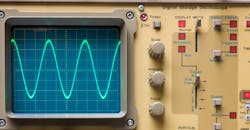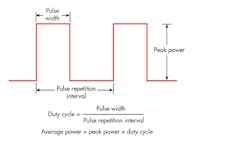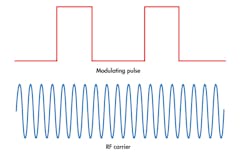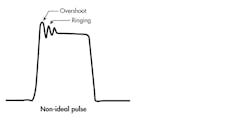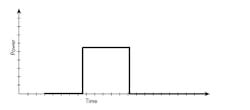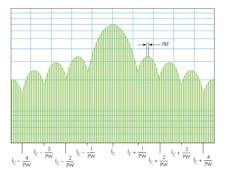A Primer on Pulsed Measurements
Download this article in PDF format.
Continuous-wave (CW) signals are often used in RF/microwave applications. Measuring the power level of such signals typically involves a CW power sensor. Many diode-based CW power sensors have a wide dynamic range, allowing them to be an excellent choice for measuring unmodulated CW signals. However, some RF/microwave applications utilize pulsed signals rather than CW signals.
For instance, radar applications often use pulsed RF signals, which can be described as periodic bursts of an RF carrier. In essence, these signals are “on” for a certain amount of time. At the end of the “on” cycle, the signal is then “off” for a period of time. While a CW or average power sensor can be used to measure pulsed RF signals, they may not always be the most effective option. Oftentimes, measuring these signals can be performed more effectively by taking a different approach. It’s therefore important to understand pulsed RF signals, as well as the techniques that can be used to measure them.
Description of Pulsed RF Signals
Figure 1 shows an ideal pulse. Among the characteristics that describe pulses are peak power, average power, pulse repetition frequency (PRF), pulse repetition interval (PRI), pulse width, duty cycle, rise time, and fall time. PRF is the rate at which pulses are generated. PRI is inversely related to the PRF. Pulse width is simply the duration of a pulse. The peak power of a pulse can be seen clearly in Fig. 1. The average power of a pulse is related to its duty cycle and peak power level.
1. Shown is an ideal pulse.
A pulse-modulated RF signal is created when a pulse modulates an RF carrier. Figure 2 is an illustration of a modulating pulse along with an RF carrier. When the pulse modulates the RF carrier, the result is a pulse-modulated RF signal, shown in Figure 3.
2. Here, a modulating pulse sits alongside an RF carrier.
3. This figure illustrates a pulse-modulated RF signal.
Options for Measuring Pulsed RF Signals
Several different test instruments can measure pulsed RF signals. Two options will be discussed here: peak power meters and spectrum analyzers. Peak power meters are essential when it comes to measuring pulsed RF signals, as they provide measurement capabilities that cannot be achieved by average power meters. They can easily analyze pulsed RF signals, allowing users to measure not only peak power, but also average and instantaneous power.
Spectrum analyzers can be used to analyze pulsed RF signals in the frequency domain. Viewing such signals on a spectrum analyzer can reveal a number of potential problems. They do have a disadvantage in terms of cost, as spectrum analyzers are typically more expensive than peak power meters.
Peak Power Meters
An average power meter is commonly used to measure CW signals. Such power meters can also measure the average power of pulsed RF signals. However, average power meters cannot directly measure peak power levels.
The peak power level of a pulsed RF signal can be calculated when the average power value and the duty cycle are known quantities. Thus, an average power meter is able to indirectly measure peak power. In other words, the average power is first measured. If the duty cycle is known, the peak power can be calculated mathematically as:
However, this method of calculating peak power is only accurate in the case of an ideal pulse, such as the one shown in Fig. 1. Figure 4 shows a pulse that’s not purely rectangular. Additional factors, such as overshoot and ringing, result in a non-ideal shape. In this scenario, calculating the peak power by the method described will produce an inaccurate result. Thus, to calculate an accurate peak power value based on the average power value, the pulse must be purely rectangular and have a constant duty cycle. If these conditions are not met, the calculation will not be accurate.
4. This pulse has non-ideal characteristics.
Unlike an average power meter, a peak power meter can directly measure the peak power of a pulsed RF signal. A peak power meter would be used with a peak power sensor, which is a diode-based detector with a fast response. That response enables it to accurately measure the envelope of a pulsed signal. One drawback of peak power sensors is they generally have less dynamic range than average power sensors.
Peak power meters often have trace display capabilities, allowing one to see the envelope of a pulsed RF signal on a display (Fig. 5). In essence, peak power meters display a response similar to an oscilloscope. It should be noted that a peak power meter’s name may actually be somewhat misleading. That’s because in addition to peak power, peak power meters can measure both average power over a defined time interval and the instantaneous power at any point in time.
5. Shown is the envelope of a pulsed signal on a peak power meter display.
In addition to direct power measurements, peak power meters allow users to analyze a variety of parameters, such as pulse width, PRI, and rise/fall times. Many peak power meters also have triggering capabilities. Some provide even more advanced capabilities, such as statistical analysis.
Video bandwidth is one of the most important parameters, as it must be sufficient to accurately track the envelope of a pulsed signal. Video bandwidth and rise time are inversely related. In essence, the faster the rise time of the pulse being measured, the larger the video bandwidth must be. Video bandwidth is typically specified by manufacturers.
Spectrum Analyzers
A traditional spectrum analyzer is another instrument that can be used to measure pulsed RF signals. By using a spectrum analyzer, one can analyze a pulsed RF signal in the frequency domain. Thus, a spectrum analyzer provides information that cannot be attained by a peak power meter. Figure 6 is a generic illustration of a spectrum-analyzer display of a pulsed RF signal.
6. This display is typically seen on a spectrum analyzer when measuring a pulsed RF signal.
The pulsed RF signal’s spectrum consists of a main lobe accompanied by side lobes. The widths of the main lobe and side lobes are inversely related to the pulse width. Essentially, as the pulse width widens, the widths of the main lobe and side lobes will decrease. The spacing between each spectral component is determined by the PRF. As the PRF increases, it also widens the spacing between spectral components.
When using a spectrum analyzer to measure pulsed RF signals, one must use the proper resolution bandwidth (RBW). The spectrum analyzer’s RBW must be much less than the PRF to differentiate between each spectral component. If the spectrum analyzer’s RBW is greater than the PRF, each individual spectral component cannot be displayed. However, it’s still possible to preserve the shape of the spectrum. Therefore, this approach is still practical in many instances.
